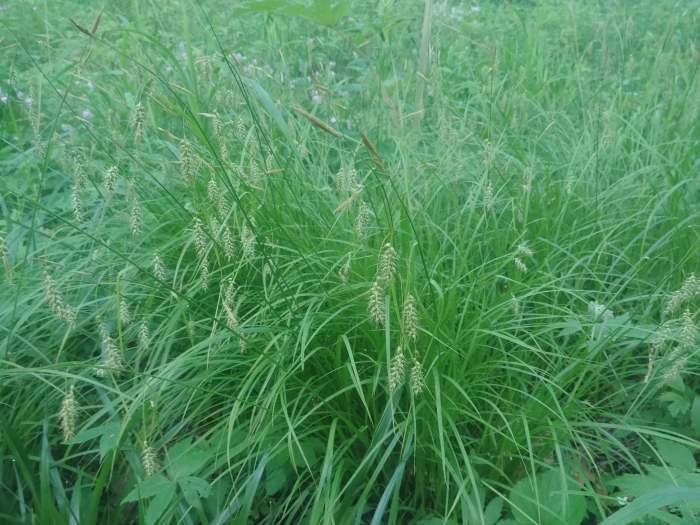Sprengel’s Sedge
(Carex sprengelii)
Sprengel’s Sedge (Carex sprengelii)
/
/

Katie Kucera
CC BY 4.0
Image By:
Katie Kucera
Recorded By:
Copyright:
CC BY 4.0
Copyright Notice:
Photo by: Katie Kucera | License Type: CC BY 4.0 | License URL: http://creativecommons.org/licenses/by/4.0/ | Rights Holder: Katie Kucera | Publisher: iNaturalist | Date Created: 2019-05-31T07:14:14-07:00 |

























Estimated Native Range
Summary
Carex sprengelii, commonly known as Sprengel’s sedge or long-beaked sedge, is a perennial herbaceous plant native to North America, particularly thriving in moist woodlands, meadows, thickets, and along stream banks. It is also found in pond and lake margins, bogs, and marshes, where it forms part of the understory vegetation. This sedge typically grows 1-3 feet tall and is characterized by its drooping seed heads, which are responsible for its common name. The seed heads emerge in late spring to early summer and are not particularly showy, but they add a fine texture to the landscape.
Sprengel’s sedge is valued for its adaptability to wet conditions and is often used in rain gardens, naturalized areas, and as a ground cover in moist, shaded sites. It prefers partial to full shade and consistently moist, well-drained soils. While it is not drought-tolerant, it can withstand occasional flooding and is useful for erosion control along waterways. This sedge is low maintenance and typically does not suffer from serious pest or disease problems. However, it can spread somewhat aggressively in ideal conditions, so gardeners should consider this when planting.CC BY-SA 4.0
Sprengel’s sedge is valued for its adaptability to wet conditions and is often used in rain gardens, naturalized areas, and as a ground cover in moist, shaded sites. It prefers partial to full shade and consistently moist, well-drained soils. While it is not drought-tolerant, it can withstand occasional flooding and is useful for erosion control along waterways. This sedge is low maintenance and typically does not suffer from serious pest or disease problems. However, it can spread somewhat aggressively in ideal conditions, so gardeners should consider this when planting.CC BY-SA 4.0
Plant Description
- Plant Type: Grass
- Height: 2-4 feet
- Width: 1.5-2 feet
- Growth Rate: Moderate
- Flower Color: N/A
- Flowering Season: Summer
- Leaf Retention: Evergreen, Semi-deciduous
Growth Requirements
- Sun: Part Shade, Full Shade
- Water: Medium
- Drainage: Medium, Slow
Common Uses
Bird Garden, Border Plant, Deer Resistant, Low Maintenance
Natural Habitat
Moist woodlands, meadows, thickets, stream banks, pond and lake margins, bogs, and marshes
Other Names
Common Names: Sprengel’s Sedge, Long-beaked Sedge
Scientific Names: , Carex sprengelii, Carex longirostris, Carex longirostris, Carex longirostris var. microcystis, Carex longirostris var. minor, Carex sprengelii,
GBIF Accepted Name: